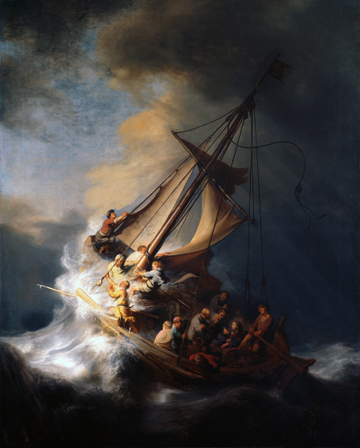The story of Jesus calming the storm (Matthew 8:23-27) has been used rather frequently to say that Jesus can calm the “storms” of your life. There are two obvious problems with this interpretation even though they may be well-intentioned. They may be well intentioned when the interpreter wants to give his audience hope, and gives them hope in Jesus, all of which is commendable. The difficulty is, of course, that if it is a hope that Jesus does not give, then one is promising something that may not happen. What the interpreter wants to do is to give the hope that Matthew intended to give, no more, no less.
Now the first thing that is obviously wrong with this is that this application isn’t true. Jesus has not promised to calm the “storms” of your life. He has promised to go through your difficulties with you (if you are a believer), take you to heaven when you die, and raise up your body to live with Him on a new earth forever. But . . . many of the “storms” of your life will stay “stormy” until you die. And, the ultimate “storm” is your own death, which will not (unless the rapture occurs) be calmed. You will have to go through that storm.
The second item is not theological, but is simply hermeneutics. The “storm” in the story is a real storm. While the word is the same, the meaning of “storm” is clearly not meaning the “storms” of life, but a “storm” over the Sea of Galilee. Again, they are the same word, but a totally different meaning. That would be like me telling you to “pack your bags and put them in the trunk” and “you pack your bags” and try to stuff them up an elephant’s trunk. They are the same word, but a totally different meaning. And without the author showing you that he intended to play on the word “storm,” it is totally in the imagination of the interpreter. In fact, doing this is not just imaginative, to be kind, but is treating the text as a very low piece of literature to be manipulated at the behest of the interpreter. It is denying the author his inspired meaning for the meaning of the uninspired interpreter.
Now, as I’ve said before, these are part of a larger story, that is “The Biblical Story.” If one is aware of the larger story, they will recognize this story has occurred before in Biblical history. It is the story of Jonah. In Jonah chapter 2, Jonah has fled God and is on a ship with pagan sailors. God “throws” a storm and the sailors search for Jonah, who is asleep in the ship. Jonah arises, admits that it is his God that is creating the storm in order to chastise him for his disobedience. The sailors throw Jonah overboard and God calms the storm.
Now, fast forward to Jesus. Again the storm comes up, and again the sailors (now the disciples) go to awake Jesus. But this time, instead of another Jonah admitting that it is his sin that has caused the storm, Jesus replies to the disciples, “Why are you afraid, o ye of little faith?” In other words, Jesus is asking them, ‘Who do you think is sleeping here? Do you think that I am another Jonah?’ Or, stated positively, Jesus is telling them, “I am not another Jonah, I am the Christ, the Son of God. Why do you fear?”
With that then Jesus calms the storm. Of course, in the Jonah story, God calmed the storm. It is not much for the disciples to see the comparison. And their conclusion, the one that Matthew has included to help you with the application, is “Who is this Man, that even the wind and the waves obey Him?” The answer Matthew wants you to come to through the eyes of these disciples is that this is God Himself in the form of a Man.
You see, you will never get to ride in a boat on the Sea of Galilee with Jesus, nor any other body of water. You will never get to watch Him raise His hand and the waves and wind cease . . . immediately. The disciples did. They are telling you about Jesus when He was there, so you will believe in Him, though He isn’t here (in person).
“Who is this Man . . . ?”
Written: Dr. Charles Baylis, January 26, 2015
Painting Credit: Rembrandt, “The Storm on the Sea of Galilee,” 1632.

